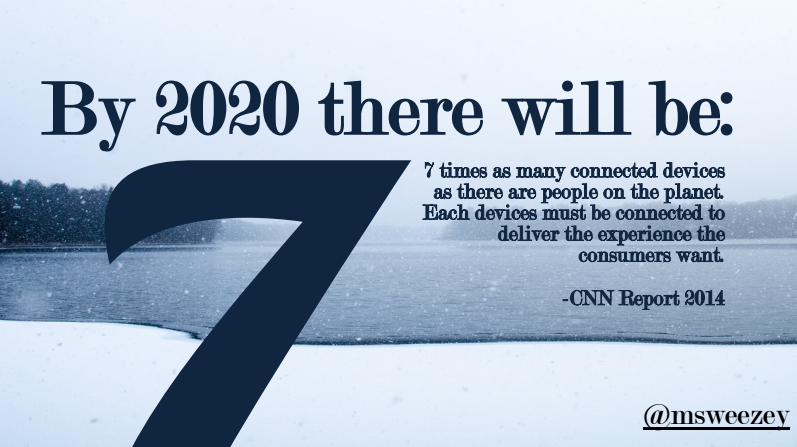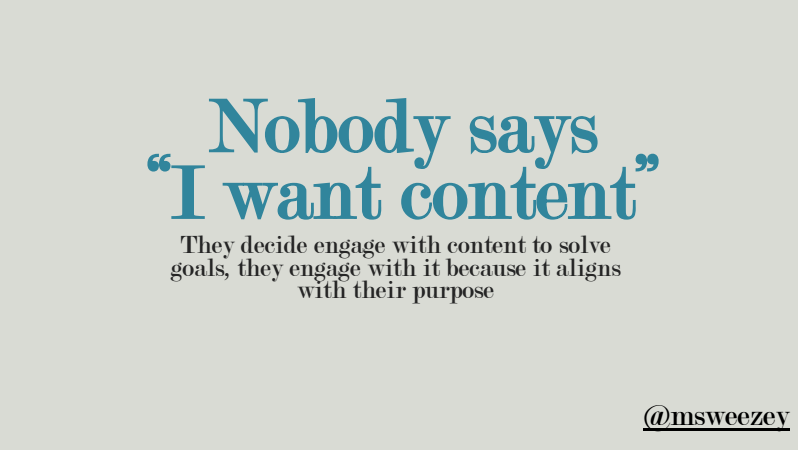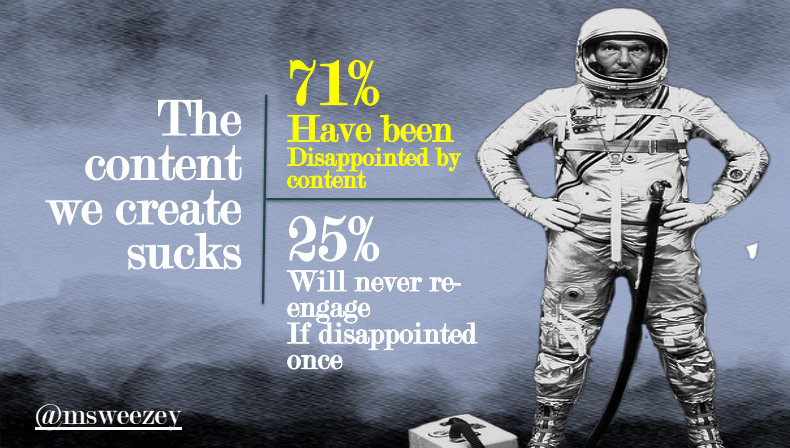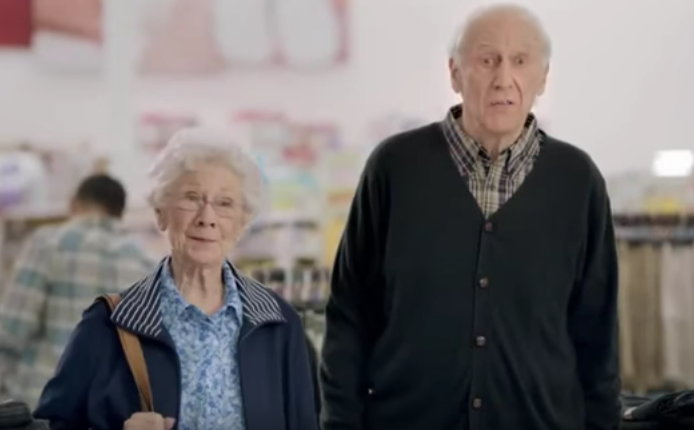 In 1960, there were only five marketing channels to master, now there are hundreds. We are living in a radically new environment. Media dictates what type of connections can exist, and what is possible. When the media environment shifts, it has massive effects on the relationship between buyers and sellers.
In 1960, there were only five marketing channels to master, now there are hundreds. We are living in a radically new environment. Media dictates what type of connections can exist, and what is possible. When the media environment shifts, it has massive effects on the relationship between buyers and sellers.
A Revolution In Media
Not since Guttenberg has there been such a revolution in media, and in his case the printing press that led to the Enlightenment was one-directional and quite expensive to produce.
Now, sharing media is easy and cheap for everyone. It is a totally frictionless experience for the first time in human history. In fact, according to data from the Chief Economist at the World Bank, 2007 marks the year that more media was created by consumers than businesses.
Yet the foundations of marketing all connect back to the “Golden Era” of Marketing of the 1950s, where the entire process was tightly controlled and there were barriers to entry at every step. In this new environment, do you think the old “Mad Men” rules apply? Or do we need to fundamentally change our approach?
It’s difficult to objectively grasp the magnitude of this revolution because we are living through it. Like the proverbial frog that gets boiled in a gradually heating pot, we absorb the massive changes in our media environment incrementally and are blind to their scale and ramifications. We must strive to understand this new environment if we hope to compete in it.
Marketing By Heuristics
When you check out your email inbox, do you read every single one and then delete, or first delete the junk before focusing on the rest? Odds are you do the latter, you disqualify before your qualify.
But no one taught you that. There is no class on how to email, or for that matter how to use Google to research a topic. Yet we are mostly all proficient at this. We learn how to do these things mostly by ourselves, for ourselves. Then human nature takes over and we form heuristics for these processes to break them down into intuitive and highly repeatable steps. By tapping into the nature of these heuristics, we can gain insights into how people discover and engage with content.
As a brand, how do you rise above the remorseless delete key?
Message Volume vs. Power
 A 2014 study by CNN predicts that by 2020 there will be seven times as many connected devices as people on the planet, and they’ll need to be connected to deliver the experiences customers demand.
A 2014 study by CNN predicts that by 2020 there will be seven times as many connected devices as people on the planet, and they’ll need to be connected to deliver the experiences customers demand.
As the quantity and type of media continues to explode, what sort of content will cut through the noise?
Would you consider your goddaughter singing you happy birthday live through Skype “content,” or a powerful life moment? Clearly, that birthday message has power, and there’s no way it will get lost amid all the infinite noise of businesses vying for consumer attention.
This demonstrates the concept of the signal-to-noise ratio, or the value of something relative to all available information in a system. In this case, the Internet. To avoid being written off as noise, businesses need to resonate by adapting to how people find and engage content.
What People Want
Sales is the most distrusted profession in America according to Gallup. Advertising is the 4th most distrusted, after congressional representatives and lawyers. Why is this? Because salespeople try to speak with the golden tongue, to get you to do what they want you to do. Marketers and advertisers are thought to do the same, except with their golden pen. You can make your own conclusions about the politicians and lawyers!
As a result, sales and marketing types tend to think about content as something you try to put in front of someone repeatedly and hope for the best.
Except no one ever got online and said, “What I really want is content!”

People are looking for honest and authentic experiences. That may just sound intuitive, but it’s also the conclusion of Joseph Pine, TED-talker, and author of The Experience Economy.
People don’t want “content,” they want to pursue their pathways of self discovery and find their way through the customer journey. A business can’t push a customer into the next step of a buying process. He or she must move from one stage to the next by themselves. Only when customers find on their own information that’s relevant to their purchasing stage will that content resonate. The people set the pace, not the business.
Producing Content With Purpose
 The verdict is in, and the content we create, by and large, sucks. Fully 71% of people have been disappointed by content, and 25% of those people will not re-engage a brand after the initial poor experience.
The verdict is in, and the content we create, by and large, sucks. Fully 71% of people have been disappointed by content, and 25% of those people will not re-engage a brand after the initial poor experience.
An effective strategy must recognize how and why people consume media online and in particular on social media, and respond in context. There is an opportunity for a brand to engage customers with a combination of human and automated interactions to build rapport, overcome simple objections, and create a strong and lasting relationship with the brand.
There is no longer a path to purchase, but a Path to Purpose. Buyers paths are constant strings of moments intertwined together equaling an experience, fulling a buyers purpose. What are you buyers purpose for engaging with you?” – Google Think, Path to purpose
So why are people searching online? There are three primary reasons. To escape from their day, discover new items of interest, and validate their presence. Again, they are not looking for “content.”
Escape
If you saw a CEO pick up their mobile device, you might think they’re checking the stock price or responding to an urgent message. That may be the case, but at least 51% of the time it’s because they are bored. Just like you and me.
Content consumption is like the new smoke break. People crave an escape from their work, life, or job, and take a short break. This doesn’t mean they aren’t willing to buy something, but the preceding escape must be honest and found by the person, not contrived by a business.
 A great example of an “Escape” ad is the Caterpillar “Built for It” ad, featuring a mesmerizing game of Jenga played out by massive construction equipment. And don’t let anyone tell you your industry “isn’t on social media.” Everyone and their grandmother is on social media. Construction workers are considered one of the most difficult to target segments because of their field, but that Caterpillar ad crushed it, and they had a viral hit.
A great example of an “Escape” ad is the Caterpillar “Built for It” ad, featuring a mesmerizing game of Jenga played out by massive construction equipment. And don’t let anyone tell you your industry “isn’t on social media.” Everyone and their grandmother is on social media. Construction workers are considered one of the most difficult to target segments because of their field, but that Caterpillar ad crushed it, and they had a viral hit.
Discover
A big reason we consume content is to discover. Discovery is one of the greatest gifts of the Internet. We no longer have to be told what’s what, we can go discover it for ourselves. Discovery is extremely powerful for marketers to understand because it allows us to fulfill a desired purpose of the consumer.
Consider how much we like to discover. According to Alexa Research (2015), the top 7 websites in the world are all places for consumers to actively discover things, with Google, Facebook, and Youtube holding the top 3 spots, followed by Baidu, Yahoo, Amazon, and Wikipedia.
There are two types of discovery: active and passive. Anytime you do a search you are engaging in “Active Discovery.” This is when you are looking, seeking, or wanting to find a specific item.
Passive discovery is the secondary action of search. It is the reason people “surf” in the first place. We are passively seeking an experience, and trust the things we find on our own. Discovering something new is our purpose.
There is great economic opportunity in helping people discover things, like showing recommended items at checkout. Amazon is extremely good at this. A search of LinkedIn reveals that Amazon employs 473 “Data Scientists” to study conversions, and their effect on the customer relationship. They wouldn’t hire that many people if there wasn’t a very good reason!
Self Discovery = Trusted Content
Modern consumers build trust in a new way, by placing a great deal of value on self discovery. This can’t be bought. In fact, consumers go out of their way to block ads! If you can learn how to aid them in their discovery journey you will avoid the noise and gain their trust. At that point, you have an opportunity to sell.
Good news! Addressing this type of purpose takes some thought but not a ton of work.
Presence is the content which consumers create about themselves to validate the curated self they are projecting. Simply engaging with these activities is fulfilling their purpose, so your Likes, Shares, stars, etc. are helpful on their own.
Lary D. Rosen of the Wiley Handbook of Psychology, Technology and Society sums it up well:
“On average a person has 7.4 social channels, and will be very hard to reach on those channels due to increased competition from their friends, digital ad budgets, and ad blocking software. Mediated relationships require ‘Frequent and phatic gestures’ to build and maintain mediated relationships and so our marketing must evolve as well.”
Why do we as humans care about Presence? It appeals to four key social values:
- Self Validation – I post therefore I am.
- Societal Validation – People like my post therefore I am liked.
- Belonging (groups) – I’m a part of something, and that feels good.
- Reciprocity (the Golden Rule) – I liked something, therefore that person might like something of mine
By understanding these four values, you can discover what someone’s purpose is and how to build stronger relationships with them. Just be sure to keep your engagements human and friendly, and anything but salesy. Remember, authentic and honest is the type experiences we’re trying to create!
All Experiences Are Important
So far, we’ve discussed why and how people consume media, and how to align your strategy with a person’s purpose. Keep in mind, however, that great content alone won’t cut it.. What if your Google reviews are terrible? Or what if someone sees your promo then finds out your site is hard to navigate?

Take the award-winning Ship My Pants campaign. K-Mart spent 10 million dollars on the campaign and had a viral hit, but the store reviews were poor and the website left much to be desired. At the end of the day, it didn't matter how funny the ad was.
It’s critical to remember that a brand is the sum of all interactions. If you’re working in silos and neglecting the entire customer experience, you’re missing out. In fact, companies that excel at delivering positive total customer experience outperform the S&P index by 30%, and customer experience laggards by 65%.
So don’t put all your eggs in one area at the expense of your total brand experience.
Test Yourself
You’re hopefully now amped about creating great purpose-delivering content, and that’s awesome! But that’s not where your mission ends. To make sure your efforts are working you need to understand the impact of your content.
There’s nothing inherently wrong with surveys, forms, and questionnaires, but these are not necessary, nor are they sufficient. They tend to make the customer experience worse and—more importantly—they often eliminate the opportunity to use human intuition to glean true insight.
That’s why you need to pick up the phone and make a few calls. Ask three simple questions:
- What were you looking for when you engaged this content?
- Was the content helpful?
- How can it be better?
Who should you call for a full picture? That’s easy! Call three people who are not yet prospects, three people in your pipeline, and three customers.
Key Takeaways
The first task we have as marketers is to realize we’re in a new environment with new rules and expectations. We are the proverbial frogs in an increasingly noisy world. No one cares about our “content,” per se, only the extent to which a business can help fulfill a purpose.
Businesses can stand out by creating content that supports the steps of the purchasing process, and in doing so seeks to fulfill the purpose of its customers by delivering authentic and honest experiences.
In a world where we disqualify before we qualify, can you afford to do any less?

